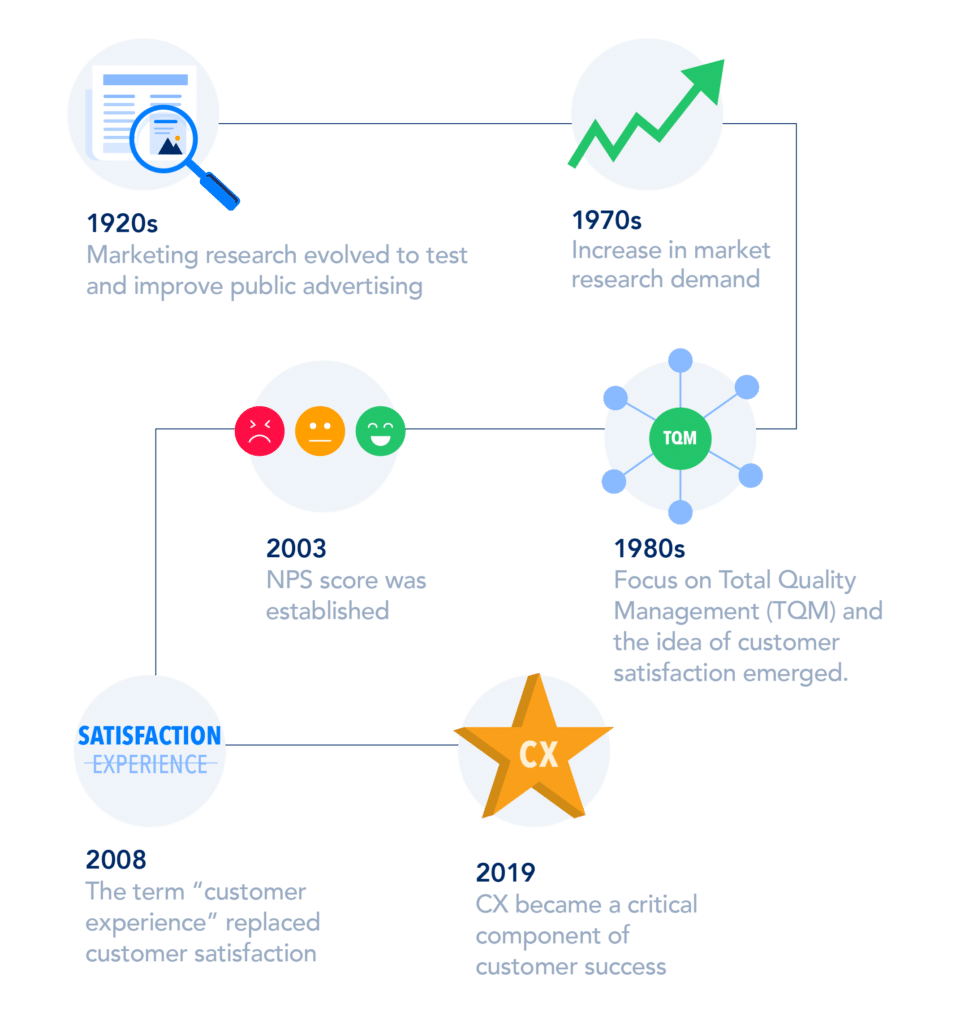After the First Industrial Revolution in the 1700s, there was a second revolution with the introduction of electricity in the 1800s. In the 1920s, market research evolved to test and improve public advertising. Psychologists such as Dan Starch and George Gallup have advanced the burgeoning field of market research through the application of mathematical and scientific principles.
Amid the rise in consumerism after the Second World War, market research finally began to develop as an area of its own. Market research demand, rooted in advertising and marketing, rose in the 1970’s throughout almost every industry.
Total quality management (TQM) and other customer-focused programs became popular in the mid-1980s, and eventually the idea of customer satisfaction emerged. The next major shift in customer experience arrived with the debut computer products. This was the Third Revolution of computers in the 1990s.
Product options were certainly higher than ever before, but access to information and competition was still nowhere near today’s level.
Business-friendly contracts became the rule, which resulted in decisions by retailers to concentrate mostly on sales with little to no attention paid to customer service because consumers could not easily switch to the competition.
CX did not matter too much, as agreements for both software companies and professional services served as “lock-ins” for customer loyalty. In fact, the enterprise software industry historically focused on business license deals. Once the supplier has signed such a contract, the client had little alternative but to pay for years of service and assistance.
The birth of the Internet allowed anyone to operate a business selling goods and services to everyone else in the digital world. People were no longer limited by physical location or outdated communications. This elimination of regional boundaries helped companies to significantly increase their number of prospective customers.
But the effect on sales came at a price, as consumers were encouraged to gain more access to both a company (and its competitors’) data.
The major work of Fred Reichheld, Bain, and Satmetrix appeared in the Harvard Business Review in 2003. Called the Net Promoter Scores (NPS), at the time it was a straightforward way to deal with two major issues in the CX world: ambiguity and ROI.

Second, many of the consumer voice solutions at the time had convoluted weighting schemes and metrics that were difficult for consumers to comprehend. On the other hand, to CEOs and front-line staff, NPS was understandable. It is a straightforward 11-point scale that subtracts brand critics from “promoters.” The simplicity of the idea made it more enticing and helped facilitate broad acceptance.
This improved access to information led to consumers decreasing their reliance on sales and marketing. Instead, consumers today are more likely to rely on other customers’ suggestions by way of online reviews and word-of-mouth referrals. In addition to removing physical constraints and growing access to information, the digital era has been characterized by the growth of the software as a service (SaaS) business model.
A key feature for SaaS vendors is a subscription model in which customers pay for services on a weekly, quarterly, or annual basis. Through shortening the sales cycle, the termination of long-term contracts changed CX. And the proliferation of subscription-based payment models fostered a new issue to address: churn.
Churn is when an existing customer stops working with a business that can either be measured as a product churn or a churn in sales. In any organization, some turnover is unavoidable. Nevertheless, success in a business (that is, the bottom line) depends on how small the turnover is.
This emphasis on turnover increased the value of customer support and also led to the creation of a new aspect of CX, customer satisfaction. The goal would be to maintain clients and profits.
Even though the Internet offered consumers with greater choice and data, business-friendly contracts initially remained to lock-in customers.
Contracts were still the standard ensuring some turnover protection for organizations. Plus, acquiring customers was cheap, so why would companies spend much money trying to retain customers when acquiring new ones was so inexpensive? In other words, sales and customer support simply had to do the bare minimum possible to keep consumers from straying.
The term “customer experience” did not become fashionable until 2008 when it served to replace customer satisfaction.
As of 2019, CX has developed into a strong and critical component of customer success. At a time when clients have more product choices and ability to turn to a rival, combined with increased costs for companies to win new clients, companies have begun paying much more attention to keep existing customers happy.
This is about creating solid relationships. CX proponents need to proactively help customers get more out of their purchase on day one and thus deliver a better overall experience rather than waiting for customers to have problems.
In the Fourth Industrial Revolution, the only way to achieve real company loyalty is by improving the customer experience at every stage of the business. Every department within an organization needs to concentrate on long-term customer satisfaction.


